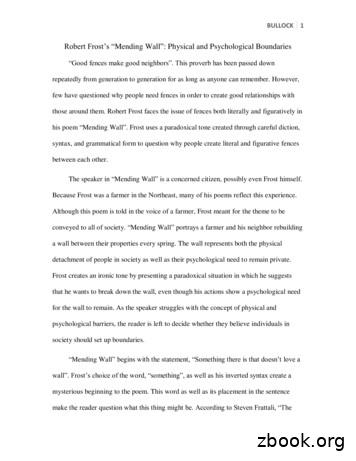Using Robert Frost’s Mending Wall To Teach Overcoming .
Language in India www.languageinindia.comISSN 1930-2940 Vol. 18:4 April 2018India’s Higher Education Authority UGC Approved List of Journals Serial Number49042 Using Robert Frost’s Mending Wall to TeachOvercoming Barriers to CommunicationDr. Deepa Sethi, Ph.D. Robert Frost 1864-1963Courtesy: https://commons.wikimedia.org/wiki/File:Robert Frost NYWTS 4.jpgImportance of Communication and Communication SkillsCommunication is the heartbeat of every relationship. It is the very pivot aroundwhich our relationship with the various stakeholders of our life revolves. While it is thelifeblood of every organization, it is also the essence of a family. Considering the mammothworth of communication, we still have a hope. We are all born communicators. When aninfant is born, it makes a sound (in lay man’s terms, cries) and that communicates the arrivalof a new member, a new life. On the other hand, when a person dies, there is silence, and thissilence communicates the departure of a member, a life. Throughout our journey on thisplanet called Earth, we are in the enduring process of polishing our already-inherentcommunication skills. Language in India www.languageinindia.com ISSN 1930-2940 18:4 April 2018Dr. Deepa Sethi, Ph.D.Using Robert Frost’s Mending Wall to Teach Overcoming Barriers to Communication 43
On Defining CommunicationSeveral experts and scholars have given different definitions of Communication.While Keith Davis (1967) states that communication facilitates the transfer of informationand understanding from one individual to another, another scholar Louis A. Allen (1958)defines Communication as everything that an individual does, when he wishes to develop anunderstanding in another individual’s mind. It is an ongoing process of combining speaking,listening, and comprehending.However, in a common person’s words, “Communication is toget the desired outcome.” In order to reach this goal, each one of us experiments with wordsand tone, and eventually achieves it. However, the process of communication comes withroadblocks, which are termed as barriers to communication.Types of Barriers to CommunicationThe types of barriers to communication are: physical/environmental barriers,psychological barriers, technological barriers, cultural barriers, organizational barriers and soon and so forth. These barriers may be at the sender’s end, receiver’s end, or in thetransmission process. These barriers may hinder the very process of communication by eithercausing distractions or problems, leading to distortion in comprehension. It is very importantto identify the barriers to communication, and fix them in order to attain the desired outcome,as stated earlier. Two major barriers to communication: physical and psychological barrierswill be discussed in the present article.Physical BarriersThese are also called environmental barriers as they can be easily observed andnoticed. These include: walls, closed doors, distance, time zone, temperature, noise etc.Psychological BarriersBarriers due to which communication is distorted due to the problems related tohuman psychology issues. These include: emotions attitudes, opinions, judgement, preconceived notions, presumptions, indifference, closed mind, anger, pride, anxiety, rigidthoughts etc. These are very complex as they are related to the human mind.Overcoming BarriersThis module on barriers to communication can be instructed in different ways:examples from personal and corporate life, movie screenings, role plays, case studies,powerpoint presentations, lecture mode etc. However, the students today are always seekingchange, they are engaged when new and innovative pedagogies are employed in the learningprocess.Use of PoetryThis article proposes the use of poetry in teaching barriers to communication. Thepoem,“Mending Wall” provides succinct examples of physical and psychological barriers tocommunication. Language in India www.languageinindia.com ISSN 1930-2940 18:4 April 2018Dr. Deepa Sethi, Ph.D.Using Robert Frost’s Mending Wall to Teach Overcoming Barriers to Communication 44
Mending WallComposed by the American poet, Robert Frost, the poem “Mending Wall” is theopening poem of his second collection of poetry titled North of Boston, published in1914.Like most of the poems in this collection, “Mending Wall” narrates a story in rural NewEngland. It talks about a fence that it re-constructed every spring between the properties oftwo New England farmers. They wonder how the wall is broken every year.In lines 1–4, the poet reflects on the fact that there is something in the environmentthat breaks down the wall every interval of time. It might be the underground water that getsfrozen in winter and the ice formed therefore expands thereby causing cracks in the wall, as aresult of which the boulders topple down. Gradually the crack becomes wide enough for twopeople to cross together through it. These lines talk about the physical barrier that hinders thetwo neighbours to communicate. It is the wall which is visible. Likewise, our communicationis shadowed by different physical barriers like: noise, distance, temperature etc which caubletrouble in communication.In lines 5–11, the poet refuses to accept that the wall might be broken by hunters. Hehad re-organized the boulders after the hunters made changes for the rabbits to come out oftheir burrows. Nonetheless, the gaps which were visible now in the wall seemed mysterious.Sometimes, the physical walls are a result of our mental blocks, resulting out of our ego andpre-conceived notions and biases, andthere is a human urge to be confined within our Language in India www.languageinindia.com ISSN 1930-2940 18:4 April 2018Dr. Deepa Sethi, Ph.D.Using Robert Frost’s Mending Wall to Teach Overcoming Barriers to Communication 45
boundaries; however something or the other often leads to the dismantling of these walls wecreate around ourselves.Lines 12 – 19are about the descriptionof the wall which stands between two pieces ofland made apart by a hill. The poet has informed his neighbour about the hole; and they havemutually decided a day to examine the damage. Having done so, the two farmers decide toreinstate the boulders on their individual side, although it is complex work because of thevarying size and shape of the stones. They believe only a miracle can keep them in place.This stands true in our communication as well. We love to work in silos. However theworkplace responsibilities, on some account or the other, bring us face to face with people wedespise and have created distance from them, for a deliberation to decide on organizationaltasks.In lines 20 – 29, the poet says that the hands of both of them, his neighbour andhimself, are cold and tired due to picking up the heavy stones. The entire exercise seemsabsurd and play-like since the wall is not required at all because the two of them have adifferent plantation. While the poet produces apples, his neighbour nurtures pine trees. Thepoet further says that his apple trees will never cross their land to eat the pine from his trees.However, the neighbour is sceptical. He believes that good fences make good neighbours.The poet does not stop his efforts of convincing the neighbour in spring again.Psychological BarrierThere is a clear psychological barrier to communication in these lines. A preconceived notion of the neighbour regarding the purpose of walls hinders him to breakthrough the fences even though the poet insists him to do so. One’s presumptions andsubjective judgement often creates psychological barriers between one and one’s receivers:listeners or readers. One finds it secure to live in one’s comfort zone whether it is thepersonal work space or one’s individual thought-process. Hence, one finds difficulty inaligning individual goals to organizational goals.Ties That Prevent Us from Getting Close to PeopleThe poet questions his neighbour in lines 30 – 41 regarding why he feels good fencesmake good neighbours. There is neither greenery nor cows to feed on them on the fences. Thepoet is at a loss to understand what the neighbour is trying to protect by restoring the wall. Hewonders that the wall is brought down by elves. The neighbour appears to him as a crude andunrefined stone-age dweller, and for whom the boulders are his weapons. These lines furtherthe notion of psychological barriers to communication. There are certain beliefs that keep ustied and prevent us from getting close to people, these beliefs make us distrust every otherperson in our surroundings and thereby affect our communication pattern with the person.Finally in lines 42 – 46, the poet feels that his neighbour, the other farmer, has a close bondwith darkness. It is not only the darkness by the shade of the trees, it is also the darknessresulting from his own closed view of the world and his inability to deviate from his father’sview that good fences make good neighbours. At times, we fail to communicate because ofour inhibitions, thereby straining our relationships at work and at home as well.To ConcludeIn conclusion, it can be said that students learn and retain better the barriers tocommunication by appreciating the two farmers’ story in the poem, “Mending Wall.”Thelesson learnt is that communication is never a monologue. In order to communicate Language in India www.languageinindia.com ISSN 1930-2940 18:4 April 2018Dr. Deepa Sethi, Ph.D.Using Robert Frost’s Mending Wall to Teach Overcoming Barriers to Communication 46
effectively, one needs to develop active listening skills. One also needs to remember that thedoors of communication should never be closed. And to achieve all this, one needs tounderstand and overcome the barriers to communication. ReferencesDavis, Keith (1967). Human Relations at Work: The Dynamics of Organizational Behavior.McGraw Hill.Louis, A. Allen (1958). Management and Organization: McGraw Hill. Dr. Deepa Sethi, Ph.D.Associate Professor – Managerial CommunicationIndian Institute of Management, KozhikodeIIM Kozhikode Campus PO,Kozhikode 673570Kerala, Indiadeepa@iimk.ac.in Language in India www.languageinindia.com ISSN 1930-2940 18:4 April 2018Dr. Deepa Sethi, Ph.D.Using Robert Frost’s Mending Wall to Teach Overcoming Barriers to Communication 47
Mending Wall Composed by the American poet, Robert Frost, the poem “Mending Wall” is the opening poem of his second collection of poetry titled North of Boston, published in 1914.Like most of the poems in this collection, “Mending Wall” narrates a story in rural New England.
The speaker in “Mending Wall” is a concerned citizen, possibly even Frost himself. Because Frost was a farmer in the Northeast, many of his poems reflect this experience. Although this poem is told in the voice of a farmer, Frost meant for the theme to be conveyed to all of society. “Mending Wall” portrays a farmer and his neighbor .
Feb 24, 2015 · Frost Is In The Air: Robert Frost's Words, Your Voice We want you to record your favorite Robert Frost poem and become a part of the Frost Is In The Air digital poem collection project. Frost Is In The Air is a project aimed at collecting diverse vo
close study of “Mending Wall” by Robert Frost). In “Mending Wall”, Frost uses an extended metaphor ( the wall) to convey an idea. Consider an idea that you want to express and then think of a metaphor that will enable you to convey your ideas in a
The conventional wisdom is that the USA PATRIOT Act tore down the wall that prevented counterterrorism officials from sharing information with one another. Yet a number of laws remain on the books that could restrict data exchange, including the National Security Act of . – Robert Frost, “Mending Wall”
Oct 20, 2014 · Mending Wall Poem by Robert Frost 886 RL 1 Cite strong and thorough textual evidence to support inferences drawn from the text. RL 4 Analyze the cumulative impact of specific word choices on meaning and tone. NA_L10PE-u08s3-brbir.indd 886 12/25/10 8:31:20 PM
use metaphor is Robert Frost. Robert Frost is one of the most popular of American poets (Faggen, 2008). Robert Frost was born on March 26, 1874, in San Francisco. He is highly regarded for his realistic depictions of rural life and his command of American colloquial speech.
Poe’s Style, Paraphrase Short Story, The Pit and the Pendulum Edgar Allan Poe Frost’s Style, Make Inferences Paired Selections Poem, Birches Poem, Mending Wall Robert Frost Cisneros’s Style and Voice, Identify Author’s Purpose Paired Selections Personal Essay, Only Daughter Fiction, from Carmelo Sandra Cisneros
HIGH RISK BAKING Although most cakes and biscuits are classed as low risk products, some fillings and finishes are more high risk. Fresh cream, some cheese cakes and royal icing made from raw egg whites are all high risk and require extra thought to ensure they are prepared safely. Cakes that require refrigeration must be kept at or below 8 C at all times with limited time out of temperature .























